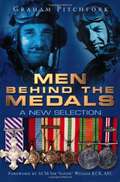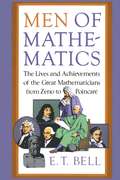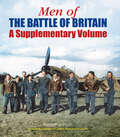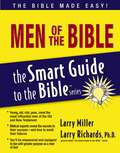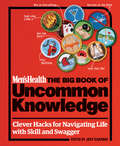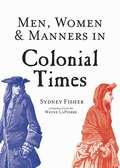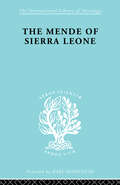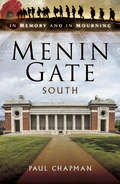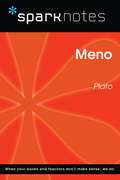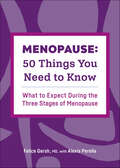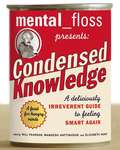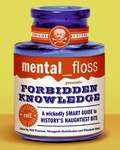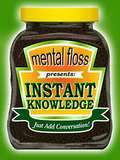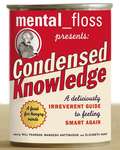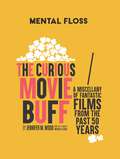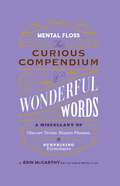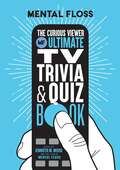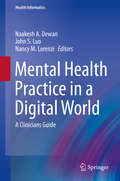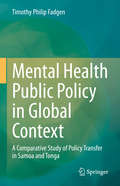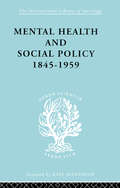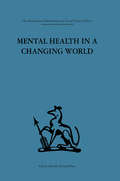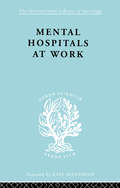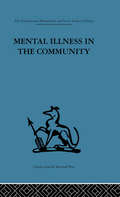- Table View
- List View
Men Behind the Medals: A New Selection
by Graham PitchforkOf the many characteristics that emerge in warfare, none generates more admiration than gallantry. Using medal groups chosen for their unique combinations of gallantry and campaign awards, Graham Pitchfork pays tribute to the bravery of twenty Allied airmen who flew combat operations during the Second World War. Encompassing a wide cross-section of operational roles, theatres, aircraft types and aircrew categories, the men behind the medals' experiences and actions are narrated in relation to the wider war. These crucial operations are seen through a variety of different actions, including a night-fighter crew and a navigator who took part in supply drops to Resistance movements. The air war at sea is seen through the experiences of a Beaufighter pilot and a Royal Navy observer who attacked the Italian Fleet at Taranto. As the Second World War generation fade into history, their exploits need to live on forever as an example for future generations. In describing the exploits of the lesser-known heroes of that air war, Graham Pitchfork has ensured that 'The Many' will never be forgotten.
Men of Mathematics
by E. T. BellHere is the classic, much-read introduction to the craft and history of mathematics by E.T. Bell, a leading figure in mathematics in America for half a century. Men of Mathematics accessibly explains the major mathematics, from the geometry of the Greeks through Newton's calculus and on to the laws of probability, symbolic logic, and the fourth dimension. In addition, the book goes beyond pure mathematics to present a series of engrossing biographies of the great mathematicians -- an extraordinary number of whom lived bizarre or unusual lives. Finally, Men of Mathematics is also a history of ideas, tracing the majestic development of mathematical thought from ancient times to the twentieth century. This enduring work's clear, often humorous way of dealing with complex ideas makes it an ideal book for the non-mathematician.
Men of the Battle of Britain: A Supplementary Volume
by Kenneth G. Wynn“Tells about various details of data, squadrons, training, life path, passport photos and more. This supplement contains addition for about 350(!) airmen.” —Aviation Book ReviewsSince it was first published in 1989, Men of the Battle of Britain, the complete third edition of which was published in 2015, has become a standard reference book for academics and researchers interested in the Battle of Britain. This remarkable publication records the service details of every airman who took part in the Battle of Britain, and who earned the Battle of Britain Clasp, in considerable detail. Where known, an individual’s various postings and their dates are included, as are promotions, decorations, and successes claimed while flying against the enemy. There is also much personal detail, often including dates and places of birth, civilian occupations, dates of death and place of burial or, for those with no known grave, place of commemoration. There are many wartime head-and-shoulders photographs.Inevitably, the passage of time ensures that there is a constant reevaluation of the wealth of information contained within Men of the Battle of Britain. At the same time, since the 2015 edition it has been possible to expand many individual entries, some 330 in total, to give some idea of the wider social context around the aircrew who earned the Battle of Britain Clasp. This has been achieved by reference to existing sources, including information supplied by The Few themselves and their relatives over many years, as well as new research.This invaluable supplement to the 2015 edition ensures that these additions and revisions are available to all researchers, historians, enthusiasts and general readers.
Men of the Bible (The Smart Guide to the Bible Series)
by Larry MillerBe Mentored by the Most Powerful Men of the BibleGod had a purpose for each man in the Bible-and He has a purpose for you. The Smart Guide to the Bible: Men of the Bible leads you to a more intimate relationship with the God of Abraham, Isaac and Jacob, of Paul, Peter, and, of course, Jesus, who was Very God and Very Man.Through the struggles and temptations of these and others, you'll discover the blessings and strength of being a man of God today.Be Smart About:Jesus, Very God & Very ManMen of StrengthMen of HumilityMen after God's Own HeartMen of FaithMen Who Were RestoredMen of DestinyAnd More!
Men's Health: Clever Hacks for Navigating Life with Skill and Swagger! (Men's Health)
by Editors of Men's HealthMen’s Health The Big Book of Uncommon Knowledge combines thousands of DIY tips, bits of advice, how-to articles, and other skills a modern man must master to be the best he can be—and have a good laugh while doing it. The ultimate insider’s guide to everything, this book is a treasure trove of career advice; sex tips; and instructions for mastering the power handshake, losing 15 pounds, wooing a girl (or a rainbow trout), surviving a bear attack (or a nasty divorce), dressing for success, cooking the perfect steak, paddling a canoe straight, curing a hangover, troubleshooting a car, changing a diaper with one hand, and more!
Men, Women & Manners in Colonial Times
by Wayne Lapierre Sydney George Fisher"In travelling from Massachusetts to the Carolinas one passed through communities of such distinct individuality that they were almost like different nations," writes author Sidney George Fisher in his preface to Men, Women & Manners in Colonial Times, in which he presented the history and culture of colonial America to his Gilded Age contemporaries, who he felt had lost an appreciation of the fascinating circumstances that created the Founding Fathers and the Revolution. In the almost two hundred years of colonial life preceding the Revolution, the colonies displayed a remarkable variety, from their religion, politics, and countries of origin, to their dress, lifestyles, and character. Fisher cites primary documents such as colonial newspapers and the diaries of common men and women as well as famous political figures. He addresses the credibility of legends of our forefathers still told today (George Washington "was an extremely sociable man, and he could not have lived in Virginia and been otherwise") and the riveting colonial folklore lost to the ages (for instance, "John Randolph, of Virginia, who, seeing a drove of mules passing through Washington on their way to the South, said to Marcy, of Connecticut, 'There go some of your constituents.' 'Yes,' said Marcy, 'going to Virginia to teach school.' ").Discover colonial architecture, illustrated here with photogravures, and colonial pastimes, including the favorites of George Washington and much of colonial Virginia: card playing and foxhunting. Learn the outstanding literary tradition of Massachusetts, the regularity of fighting off bears in New Hampshire, the popularity of horseracing in Maryland, Blackbeard's headquarters in North Carolina, the women who ran the South Carolina plantations, the cleanliness of the New York Dutch as they contemplated "their comfort and prosperity while they smoked their pipes . . . willing that the rest of the world would enjoy the same pleasure."
Mende Of Sierra Leone Ils 65 (International Library of Sociology)
by Kenneth LittleThe social, political and economic impact of the decline of the old colonial powers in Africa, India and the Middle East are still key areas of scholarly research and debate. Based on careful social observation and empirical research, these titles explore the tension between agriculture and industry in developing economies, and trace the complex political process of independence. Aimed at administrators and academics, these studies are central to Development Studies, and also present the work of renowned anthropologists such as Raymond Firth.
Menin Gate South: In Memory and In Mourning (In Memory and in Mourning)
by Paul ChapmanThis is a comprehensive and highly emotive volume, borne of years of intensive research and many trips to the battlefields of the Great War. It seeks to humanise the Menin Gate Memorial (South), to offer the reader a chance to engage with the personal stories of the soldiers whose names have been chiseled there in stone. Poignant stories of camaraderie, tragic twists of fate and noble sacrifice have been collated in an attempt to bring home the reality of war and the true extent of its tragic cost. It is hoped that visitors to the battlefields, whether their relatives are listed within or not, will find their experience enriched by having access to this treasure trove of stories.
Meno (SparkNotes Philosophy Guide)
by SparkNotesMeno (SparkNotes Philosophy Guide) Making the reading experience fun! SparkNotes Philosophy Guides are one-stop guides to the great works of philosophy–masterpieces that stand at the foundations of Western thought. Inside each Philosophy Guide you&’ll find insightful overviews of great philosophical works of the Western world.
Menopause: What to Expect During the Three Stages of Menopause
by Alexis Perella Felice GershDiscover what happens to your body during the three stages of menopause Understanding the why and how of menopause empowers you to shape your own journey during this important transition. This book is an honest, accurate guide to menopause and how it impacts your body. It's full of information that prepares you for what may lie ahead and helps you handle any health concerns you may have.This menopause book can help you:Know what to expect—Learn about the three stages of menopause, 50 of the most common symptoms, why they occur, and the best ways to support yourself as your body changes.Understand the science—Find research-supported facts and practical advice to help you navigate the ups and downs of perimenopause, early menopause, and late menopause.Find an inclusive approach—Discover concise and practical guidance that gives you the tools to approach menopause in a way that feels right to you and your body.Take control of your menopause journey with help from this practical guide.
Mental Floss Presents Condensed Knowledge
by Elizabeth Hunt Will Pearson Mangesh HattikudurLoaded with meaty trivia and tasty, bite-sized facts! mental_floss is proud to offer a delicious, hearty helping of brain-food that's sure to fire up your neurons and tantalize your synapses. Condensed Knowledge is a mouthwatering mix of intriguing facts, lucid explanations, and mind-blowing theories that will satisfy even the hungriest mind! Ingredients include: 5 tiny nations that get no respect * 4 civilizations nobody remembers * 5 classics written under the influence * 4 things your boss has in common with slime mold * 3 schools of thought that will impress the opposite sex * 4 things Einstein got wrong * 5 classical tunes you know from the movies * 3 famous studies that would be illegal today * 2 religious mysteries solved by chemistry * 5 scandals that rocked art, and much more ...
Mental Floss Presents Forbidden Knowledge
by Editors Of Mental FlossThink of anything bad, from art heists to Genghis Kahn, and it's likely to be included in this wickedly smart and humorous guide to the seedy underbelly of basically everything. The brainiac team at "mental_floss", creators of the hit magazine and last year's Condensed Knowledge, have scoured the darkest, dirtiest corners of history and the globe to gather this ultimate collection of the bad stuff you're not supposed to know and you certainly never learned in school. Organized by theme, with chapters for each of the seven deadly sins, the book includes feuds, plagiarists, hoaxes, lies, schemes, scandals, evil dictators, mob bosses, acts of revenge, angry queens, cannibals and much more, all organized into bite-sized--albeit foul-tasting--lists (i.e."The Fascist Style Guide: Five Dictator Grooming Tips", "Four Biblical Girls Gone Wild" and "Three Delicious Animals We Charbroiled Into Extinction."). It's the perfect way to add some spice to a dull conversation and proves that learning can be not only easy, but exquisitely sinful.
Mental Floss Presents Instant Knowledge
by Julie Sussman Will PearsonMental_floss is proud to present a full-bodied jolt of inspiration for thirsty minds on the go. Blended with titillating facts, startling revelations, and head-scratching theories collected from around the world, Instant Knowledge will jumpstart riveting exchanges at cocktail parties, the watercooler, or any powwow. Building upon the success of the mental_floss magazine, CNN news segment, board game, and mentalfloss.com website, comes a book filled with interesting facts and theories.
Mental Floss Presents: Condensed Knowledge
by Elizabeth Hunt Will Pearson Mangesh HattikudurCollection of fascinating facts, theories, explanations, and trivia related to a variety of different subjects. Categories include literature, music, science, religion, history, and more.
Mental Floss: A Miscellany of Fantastic Films from the Past 50 Years
by Jennifer M. Wood Mental FlossCinephiles rejoice! From Mental Floss, an online destination for more than a billion curious minds since its founding in 2001, comes the ultimate book for movie lovers. The Curious Movie Buff is filled with fascinating facts and behind-the-scenes insights about the making of your favorite movies from the last 50 years. Every film fan will find something to love, with the team at Mental Floss profiling more than 60 films of the past half-century, from well-known blockbusters to critical favorites and cult classics. The highlighted titles span across various decades and genres and include iconic franchises like Star Wars and The Lord of the Rings, Oscar-winning classics like The Godfather and Titanic, rip-roaring comedies from Blazing Saddles and The Big Lebowski, indie hits like Reservoir Dogs and Paranormal Activity, and superhero favorites such as Superman and The Dark Knight. Throughout are quirky sidebars from the Mental Floss archives, such &“Marvel Cinematic Universe Movie Locations You Can Visit IRL,&” &“Remakes That Are Better than the Original Movie,&” The 25 Best Movie Endings of All Time,&” &“Summer &‘Blockbusters&’ That Completely Tanked at the Box Office,&” and &“The Best Movie Trailers Ever.&” TRIVIA ABOUT MORE THAN 60 MOVIES: Get the inside scoop, fascinating facts, and behind-the-scenes trivia on the greatest movies from the past 50 years, from serious dramas such as The Godfather to seriously funny comedies like The Big Lebowski FASCINATING AND INLayoutIVE LISTS: Learn about movie locations you can visit, what movies have the best endings, and which movies scraped the bottom of the barrel with Mental Floss&’s info-packed lists SOMETHING FOR EVERYONE: Whether you&’re in the mood for a classic, jonesing for a good Western, wondering what sci-fi films you&’ve missed, or just want to discover a new movie, the team at Mental Floss will steer you in the right direction THE PERFECT GIFT FOR MOVIE FANS: Mental Floss: The Curious Movie Buff is the ideal gift for the film enthusiasts in your life.
Mental Floss: A Miscellany of Obscure Terms, Bizarre Phrases & Surprising Etymologies
by Erin McCarthy Mental FlossEver wonder if there is a synonym for the word synonym? Or why people really hate the word &“moist?&” Maybe you want to know why we tell a person to take something &“with a grain of salt,&” or why McDonalds went to war with a dictionary. From obscure words to the best literary insults ever written, this linguistic miscellany is sure to spice up your vocabulary, make you a whizz at word games, and prepare you for plenty of wordy repartee for your next soiree, with some of the most bizarre terms you never knew you needed. A CACOPHONY OF WORDS: Learn the meaning and surprising history of hundreds of words and phrases LOTS OF LISTS: Discover curated collections of literary insults, old-timey words, popular slang, and much more WORD GAME WIZ: Includes tips for mastering popular word games from Scrabble to Wordle WIT FOR WRITERS: Writers looking for just the right word will be inspired by hundreds of unusual and obscure words REFERENCE FOR READERS: Fans of every genre, from Norse Myths to Victorian Romance will find histories, origins, and backstories of the words that make up their favorites reads COMPLETE YOUR COLLECTION: Mental Floss: The Curious Reader, Mental Floss: The Curious Movie Buff, and Mental Floss: The Curious Viewer are also available.
Mental Floss: The Curious Viewer Ultimate TV Trivia & Quiz Book
by Jennifer M. Wood Mental FlossImpress your friends, family, and coworkers with fascinating facts about favorite TV shows and test your own TV trivia knowledge with dozens of challenging and entertaining quizzes. Did you know... Succession relies on &“wealth consultants&” to ensure authenticity on how the richest of the rich live? A fan of The Office, after recalling the episode where Steve Carell&’s character arranges a (disastrous) CPR training session, successfully performed CPR on an unconscious stranger? Fraggle Rock was the first American TV series broadcast in Russia? Learn the stories behind these obscure TV tidbits and much more! With fun trivia, challenging quizzes, and log pages for your own lists, Mental Floss: The Curious Viewer Ultimate Quiz and Trivia Book will become as indispensable for your next binge-watch as your remote control. DOZENS OF FUN AND CHALLENGING QUIZZES: Test your TV knowledge with quizzes like "Two Degrees Of" your favorite celebrities, and "Match the Quote to the Simpsons Character" TRIVIA ABOUT MORE THAN 100 TV SHOWS: Get the inside scoop, fascinating facts, and mind-boggling trivia on the greatest shows from the past 20 years, from serious dramas such as Law and Order to seriously funny comedies like Ted Lasso MAKE IT YOUR OWN: Dozens of pages with fill-in lists, such as "Shows I Want to Binge" and "My Favorite TV Quotes" to "Shows I Started but Never Finished" and "My Favorite Shows of All Time."
Mental Health Handbook for Schools
by Mary Atkinson Garry HornbyAs the government strives for a more inclusive education policy, more and more teachers find themselves in the frontline when dealing with children with mental health problems. Many have not had training in such matters and so feel unprepared and uncertain when faced with difficult situations.The Mental Health Handbook for Schools provides valuable information on a comprehensive range of mental health problems with which teachers are often confronted.Drawing on up-to-date research and practice in these areas the book considers what schools can do, within the special needs framework, to help pupils with these problems. It usefully reflects on the role of the mental health services in relation to schools and how schools can adopt a whole-school preventative approach to mental health problems.The authors address an extensive range of mental health problems including Attention Deficit/Hyperactivity Disorder, eating disorders, substance abuse, obsessive-compulsive disorders and schizophrenia. They also cover situations that can often lead to the development of mental health problems including bullying, divorce and marital conflict, bereavement and physical, sexual and emotional abuse.
Mental Health Practice in a Digital World
by Nancy M. Lorenzi Naakesh A. Dewan John S. LuoThe purpose of the Mental Health Practice in a Digital World: A Clinicians Guide book is to prepare clinicians to understand, critically evaluate, and embrace well-designed and validated technologies that have the potential of transforming the access, affordability, and accountability of mental healthcare. The reader will become aware of the practical applications of technology in mental health as well as research supporting information technology tools, policy debates. Each chapter contains either examples or scenarios that are relevant to the current practice of mental health care. Policy makers, application developers, scientists, and executives that have lead or supported the use of technologies in real world practice are chapter authors. The goal for this book is to be the key resource for current and future mental health clinicians in the U. S. and around the world to become familiar with technology innovations and how they impact and improve clinical practice.
Mental Health Public Policy in Global Context: A Comparative Study of Policy Transfer in Samoa and Tonga
by Timothy Philip FadgenThis book explores the development of mental health systems in the Pacific Island Countries (PICs) of Samoa and Tonga through an examination of several policy transfer events from the colonial to the contemporary. Beginning in the 1990s, mental health became an area of global policy concern as reflected in concerted international organisation and bilateral aid and development agendas, most notably those of the World Bank, World Health Organization, and the governments of Australia and New Zealand. This book highlights how Tonga and Samoa both reformed their respective mental health systems during these years, after relatively long periods of stagnation.Using recent scholarship concerning public policy transfer, this book explains these policy outcomes and expands it to include consideration of the historical institutional dimensions evidenced by contemporary mental health systems. This book considers three distinct levels of policy implicated in mental health system transfer processes from developed to developing nations: colonial authority and influence; decolonisation processes; and the global development agenda surrounding health systems. In the process, the author argues that there are in fact three levels of policy change that must be accounted for in examining contemporary policy change. These policy levels include formal policy transfers, which tend to be prescriptive, involving professional problem construction and the designation of appropriate state apparatus for curative or custodial care provision; quasi-formal transfers, which tend to be aspirational and involve policy instruments developed through collaborative, participatory processes; and informal transfers that tend to be normative and include practices by professional actors in delivering service merged with traditional cultural beliefs as to disease aetiology as well as reflecting a deep understanding of the cultural context within which the services will be delivered. This book argues that a renewed focus on the importance of public policy and government institutional capacity is necessary to ensure human rights and justice are secured.
Mental Health and Criminal Justice
by Jr. A. Segal L. T. Winfree S. FriedmanIn this student-friendly text, a team of respected scholars balances practical knowledge of how the mental healthcare system operates in conjunction with the criminal justice system, with an analytical framework that looks at how the quality of that collaboration is reflected in the issues, processes, and outcomes of both institutions. Professors and students will benefit from an accessible new text that informs and explores: - The role of mental healthcare law and procedure in the criminal justice system - How mentally ill clients are processed through the criminal justice system - Mental healthcare terms, resources, and treatment programs - Contemporary issues in mental health and criminal justice, such as the treatment of mentally ill juveniles inside the criminal justice system, and lack of full access to mental healthcare for at-risk groups - Discussion of systemic interface and entropy, two central themes to guide student analysis of issues and examples drawn from real life Mental Health and Criminal Justice is designed with a wealth of features for study and review, including: - Learning Objectives - Framing the Issues - Prologues and Epilogues that frame issues and provide vivid examples - Key Terms, highlighted in the text and defined in the Glossary - Text boxes that expand on points of interest - Summary and Chapter Review Questions at the end of each chapter
Mental Health and Social Policy, 1845-1959 (International Library of Sociology)
by Kathleen Jones"First Published in 1998, Routledge is an imprint of Taylor & Francis, an informa company."
Mental Health in a Changing World: Volume one of a report on an international and interprofessional study group convened by the World Federation for Mental Health
by Kenneth Soddy Robert H Ahrenfeldt Mary C KidsonTavistock Press was established as a co-operative venture between the Tavistock Institute and Routledge & Kegan Paul (RKP) in the 1950s to produce a series of major contributions across the social sciences. This volume is part of a 2001 reissue of a selection of those important works which have since gone out of print, or are difficult to locate. Published by Routledge, 112 volumes in total are being brought together under the name The International Behavioural and Social Sciences Library: Classics from the Tavistock Press. Reproduced here in facsimile, this volume was originally published in 1965 and is available individually. The collection is also available in a number of themed mini-sets of between 5 and 13 volumes, or as a complete collection.
Mental Hospitals at Work (International Library of Sociology)
by Kathleen Jones Roy SidebothamFirst published in 1998. Routledge is an imprint of Taylor & Francis, an informa company.
Mental Illness in the Community: The pathway to psychiatric care (Social Science Paperbacks Ser.)
by David Goldberg Peter HuxleyTavistock Press was established as a co-operative venture between the Tavistock Institute and Routledge & Kegan Paul (RKP) in the 1950s to produce a series of major contributions across the social sciences. This volume is part of a 2001 reissue of a selection of those important works which have since gone out of print, or are difficult to locate. Published by Routledge, 112 volumes in total are being brought together under the name The International Behavioural and Social Sciences Library: Classics from the Tavistock Press. Reproduced here in facsimile, this volume was originally published in 1980 and is available individually. The collection is also available in a number of themed mini-sets of between 5 and 13 volumes, or as a complete collection.
